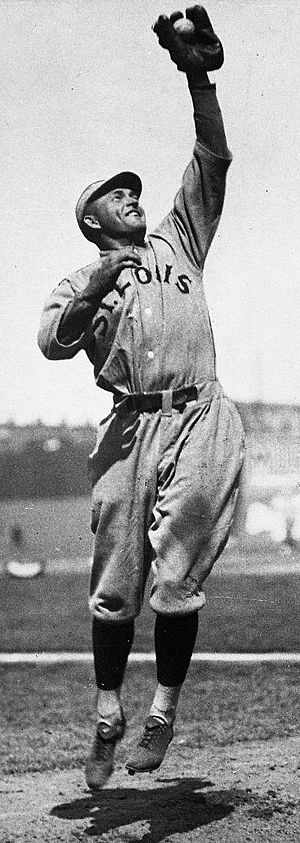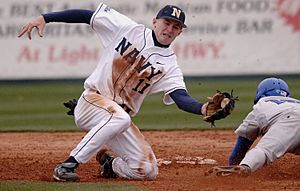Catch (baseball) facts for kids

In baseball, a catch is when a player on defense (called a fielder) securely grabs a ball that has been hit by the batter, while the ball is still in the air. The fielder must hold onto the ball until they choose to let it go. When a catch happens, the batter is out! Also, any runners on base must touch their base again (this is called tagging up) before they can try to run to the next base.
Contents
What Makes a Catch?
In baseball, a catch is a bit different from other sports like American football. It's not enough to just hold the ball for a moment or take a few steps. A fielder might seem to catch the ball, take a few steps, and then bump into a wall or another player and drop it. That is not a catch in baseball. The fielder must keep control of the ball.
How Umpires Signal a Catch
Umpires are the officials who make calls in baseball. When a catch happens, the umpire will show the "out" signal. This is a fist raised into the air, often with a quick downward motion. Sometimes, if it's a close call, the umpire might also shout, "That's a catch!"
If the umpire thinks it was not a catch, they will use the "safe" signal. This is when both arms are swept out to the sides. They will usually say, "No catch, no catch!" to make it clear.
What Doesn't Count as a Catch?
For a catch to be legal, the fielder must catch the ball with their hand or glove. If a fielder uses their cap, a pocket, or any other part of their uniform to get the ball, it does not count as a catch. For example, if a foul ball gets stuck in the catcher's equipment (other than their glove), it's not a catch.
Also, it's not a catch if the batted ball hits a fielder, then hits a player from the other team or an umpire, and then is caught by another defensive player. The ball must be caught cleanly by a fielder.
Special Catch Situations
A catch is legal as long as any fielder finally holds the ball before it touches the ground. Runners can leave their bases the moment the first fielder touches the ball.
A fielder can reach over a fence, a railing, or a line to make a catch. They can even jump on top of a railing or a canvas that is outside the playing field. If a fan accidentally touches a fielder who is reaching over a fence and a catch is not made, it's usually not considered interference. The fielder takes that risk when reaching out.
If a fielder tries to make a catch near the dugout (where players sit) and is held up by another player (from either team) so they don't fall, and they still make the catch, it will be allowed.
Sometimes, to avoid confusion, people might say a fielder "gloved" a ball if it was a thrown ball or a ball that bounced before being caught. This helps to make sure everyone knows it wasn't a "catch" according to the official rules.


